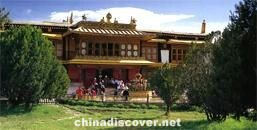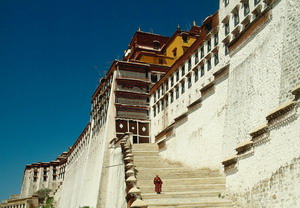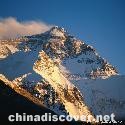Norbulingka

At the rear of the Potala Palace, a pond was left after the earth was collected for the construction of the palace in the mid 17th century. The Sixth Dalai Lama Tsangyang Gyatso built a three story octagon pavilion in the middle of the pond and took a rest in it. The pavilion has the name for a statue of Dragon King in it.
Norbulingka, meaning Jewel Park, was Dalai Lama's summer palace since the Seventh century. Its light-hearted air makes it less demanding than most sights in Lhasa. The Norbulinka is well worth a visit at festival times and public holidays. On Shoton Festival, the park is crowded with picnickers, and traditional Tibetan opera performances are also held there.
Khamsum Zilnon is a very eye-catching building behind the main gate. It was originally a Han style pavilion and later changed into a theater where the Dalai Lamas watched Tibetan opera. Tsokyil Potrang is a group of buildings on water. Dalai Lamas used to read in a hall of the palace. In 1922, the Thirteenth Dalai Lama began to build his Golden Lingka and Chensel Potrang, which is located at the back of the woods. Various flowers, grasses and trees were planted around.
Among the green trees stands a two-story building with carved beams, painted pillars, traditional upturned eaves, and corbel brackets. This is the house where Dalai Lamas stayed during the summer. The building is surrounded by trees, with ponds, terraces, and towers nearby. Thhis elegant palace contains many valuable objects, including gold, silver, jade, antiques, Buddhist artifacts, murals, and Luxury furniture.
The palace was heavily painted with murals, which bear strong Han characteristics. Takten Migyur Potrang, meaning Eternal Palace in Tibetan, was completed in 1956 for the Fourteenth Dalai Lama. Though it is called New Summer Palace, it is a very traditional architecture except for its interior modern facilities. In the palace there are many splendid murals painted by a Fourteenth Dalai Lama's painter. The topics of the murals include Tibetan officials, Sakyamuni preaching under a Bodhi tree, and Tibetan history from its founding by the Holy Monkey, the vicissitudes of Tubo Kingdom (633-844) and Tibetan Buddhism to Panchen Lama and Dalai Lama's interviews with Chairman Mao Zedong in Beijing. The present Dalai Lama's private apartment is also on view, remaining untouched. In a little sutra hall, there is a Dalai Lama's throne which is wrapped in gold foils and decorated with gems. (Source: CRIENGLISH.com)



